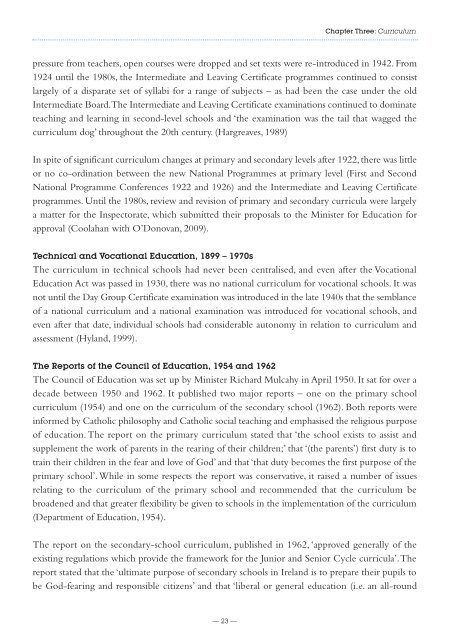Towards a Better Future
A Review of the Irish School System John Coolahan | Sheelagh Drudy Pádraig Hogan | Áine Hyland | Séamus McGuinness
A Review of the Irish School System
John Coolahan | Sheelagh Drudy Pádraig Hogan | Áine Hyland | Séamus McGuinness
Create successful ePaper yourself
Turn your PDF publications into a flip-book with our unique Google optimized e-Paper software.
Chapter Three: Curriculum<br />
pressure from teachers, open courses were dropped and set texts were re-introduced in 1942. From<br />
1924 until the 1980s, the Intermediate and Leaving Certificate programmes continued to consist<br />
largely of a disparate set of syllabi for a range of subjects – as had been the case under the old<br />
Intermediate Board. The Intermediate and Leaving Certificate examinations continued to dominate<br />
teaching and learning in second-level schools and ‘the examination was the tail that wagged the<br />
curriculum dog’ throughout the 20th century. (Hargreaves, 1989)<br />
In spite of significant curriculum changes at primary and secondary levels after 1922, there was little<br />
or no co-ordination between the new National Programmes at primary level (First and Second<br />
National Programme Conferences 1922 and 1926) and the Intermediate and Leaving Certificate<br />
programmes. Until the 1980s, review and revision of primary and secondary curricula were largely<br />
a matter for the Inspectorate, which submitted their proposals to the Minister for Education for<br />
approval (Coolahan with O’Donovan, 2009).<br />
Technical and Vocational Education, 1899 – 1970s<br />
The curriculum in technical schools had never been centralised, and even after the Vocational<br />
Education Act was passed in 1930, there was no national curriculum for vocational schools. It was<br />
not until the Day Group Certificate examination was introduced in the late 1940s that the semblance<br />
of a national curriculum and a national examination was introduced for vocational schools, and<br />
even after that date, individual schools had considerable autonomy in relation to curriculum and<br />
assessment (Hyland, 1999).<br />
The Reports of the Council of Education, 1954 and 1962<br />
The Council of Education was set up by Minister Richard Mulcahy in April 1950. It sat for over a<br />
decade between 1950 and 1962. It published two major reports – one on the primary school<br />
curriculum (1954) and one on the curriculum of the secondary school (1962). Both reports were<br />
informed by Catholic philosophy and Catholic social teaching and emphasised the religious purpose<br />
of education. The report on the primary curriculum stated that ‘the school exists to assist and<br />
supplement the work of parents in the rearing of their children;’ that ‘(the parents’) first duty is to<br />
train their children in the fear and love of God’ and that ‘that duty becomes the first purpose of the<br />
primary school’. While in some respects the report was conservative, it raised a number of issues<br />
relating to the curriculum of the primary school and recommended that the curriculum be<br />
broadened and that greater flexibility be given to schools in the implementation of the curriculum<br />
(Department of Education, 1954).<br />
The report on the secondary-school curriculum, published in 1962, ‘approved generally of the<br />
existing regulations which provide the framework for the Junior and Senior Cycle curricula’. The<br />
report stated that the ‘ultimate purpose of secondary schools in Ireland is to prepare their pupils to<br />
be God-fearing and responsible citizens’ and that ‘liberal or general education (i.e. an all-round<br />
— 23 —



